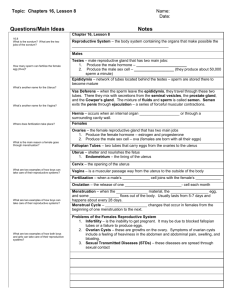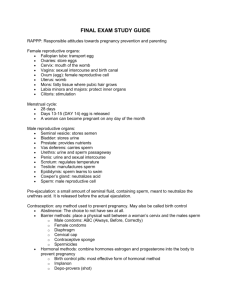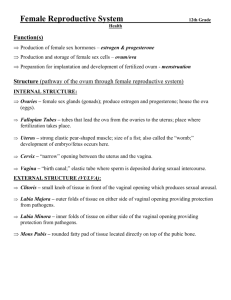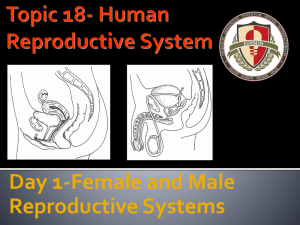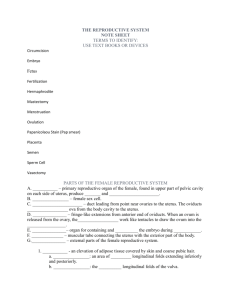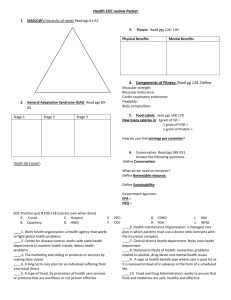(Chpt 19) Reproductive System
advertisement
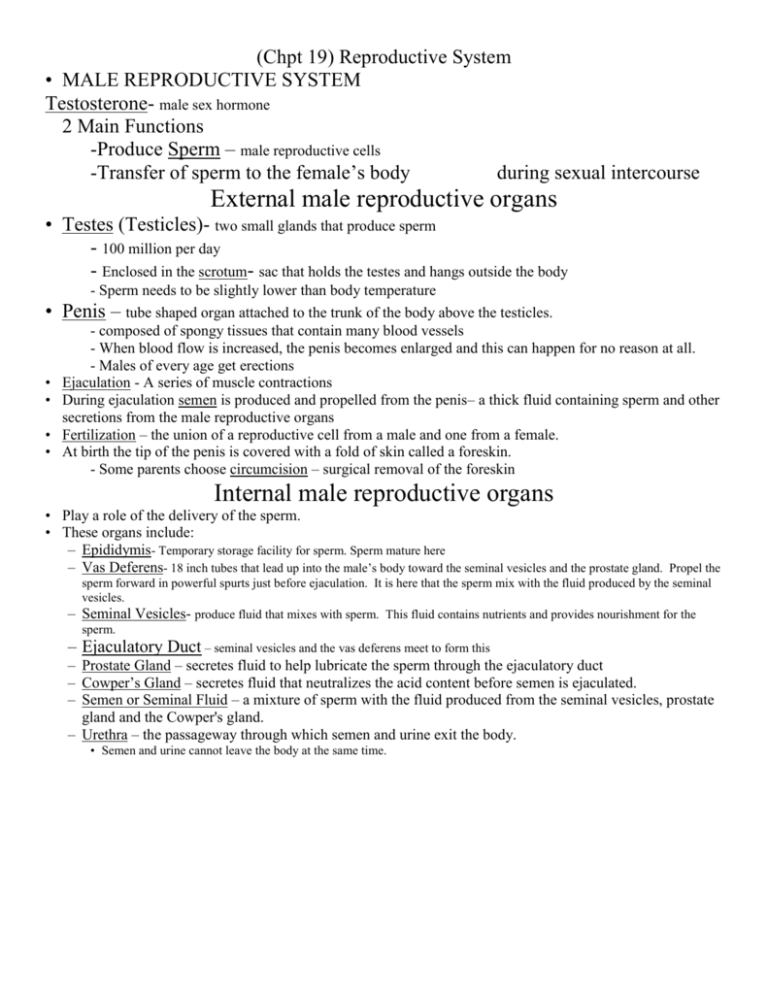
(Chpt 19) Reproductive System • MALE REPRODUCTIVE SYSTEM Testosterone- male sex hormone 2 Main Functions -Produce Sperm – male reproductive cells -Transfer of sperm to the female’s body during sexual intercourse External male reproductive organs • Testes (Testicles)- two small glands that produce sperm - 100 million per day - Enclosed in the scrotum- sac that holds the testes and hangs outside the body • • • • • - Sperm needs to be slightly lower than body temperature Penis – tube shaped organ attached to the trunk of the body above the testicles. - composed of spongy tissues that contain many blood vessels - When blood flow is increased, the penis becomes enlarged and this can happen for no reason at all. - Males of every age get erections Ejaculation - A series of muscle contractions During ejaculation semen is produced and propelled from the penis– a thick fluid containing sperm and other secretions from the male reproductive organs Fertilization – the union of a reproductive cell from a male and one from a female. At birth the tip of the penis is covered with a fold of skin called a foreskin. - Some parents choose circumcision – surgical removal of the foreskin Internal male reproductive organs • Play a role of the delivery of the sperm. • These organs include: – Epididymis- Temporary storage facility for sperm. Sperm mature here – Vas Deferens- 18 inch tubes that lead up into the male’s body toward the seminal vesicles and the prostate gland. Propel the – sperm forward in powerful spurts just before ejaculation. It is here that the sperm mix with the fluid produced by the seminal vesicles. Seminal Vesicles- produce fluid that mixes with sperm. This fluid contains nutrients and provides nourishment for the sperm. – Ejaculatory Duct – seminal vesicles and the vas deferens meet to form this – Prostate Gland – secretes fluid to help lubricate the sperm through the ejaculatory duct – Cowper’s Gland – secretes fluid that neutralizes the acid content before semen is ejaculated. – Semen or Seminal Fluid – a mixture of sperm with the fluid produced from the seminal vesicles, prostate gland and the Cowper's gland. – Urethra – the passageway through which semen and urine exit the body. • Semen and urine cannot leave the body at the same time. (Chpt 19) Reproductive System • FEMALE REPRODUCTIVE SYSTEM 3 Main Functions -Produce Ova – female reproductive cells -Receive sperm from the male -Provide protection and nourishment to the ova through birth Female reproductive organs • Ovaries- the female sex glands that house the ova and produce female sex hormones – at birth females have 400,000 immature ova in the ovaries – hormones cause the ova to mature during the early teen years. – Ovulation- process of releasing one mature ovum each month. • Fallopian Tubes- pair of tubes with fingerlike projections that draw the ovum in and move it to the uterus – This is where sperm unite with the egg and fertilization take place • Zygote- the cell that results from the union of sperm and ovum. • Uterus- small, muscular, pear-shaped organ, about the size of a fist. This is where the zygote will go after it passes through the fallopian tubes. It attaches itself to the uterine wall. This where the zygote is housed and matured for birth. • Endometrium- inner lining of the uterus • Cervix- neck of the uterus, connects the uterus to the vagina • Vagina- a muscular, elastic passageway that extends from the uterus to the outside of the body. – Serves as the female sex organ External Female reproductive organs • Vulva – external female reproductive organs – Clitoris – a small knob of tissue in front of the vaginal opening • Rich in nerve endings and blood vessels. • Important function in producing sexual arousal. – Mons Pubis – rounded fatty pad of tissue located on top of the pubic bone – Labia Majora – outer fold of tissue on either side of the vaginal opening – Labia Minora – inner folds of tissue just inside the labia majora • Both are rich in nerve endings and blood vessels • Both serve as a line of protection against pathogens entering the body and also have a function in sexual arousal – Vaginal Opening – is present when the labia are parted. Just inside the vaginal opening is a thin membrane called the hymen. • The hymen has no known function and is not present in all females. Menstruation • The process of shedding the lining of the uterus – Each month, the uterus begins to prepare for the possible pregnancy by building up a rich, thick layer blood and other tissue. If the ovum is not fertilized or if the fertilized ovum does not attach to the uterine walls, the uterine lining is not needed. • Muscles contract causing the uterine wall to break down. • The lining passes through the cervix into the vagina and out the vaginal opening. – Usually lasts 4 to 7 days, but in some females it may last 3 days and in other 9 or 10 days – Most females begin menstruating between the ages of 10 to 15 – Most women reach menopause, which is the ceasing of mentruration at around age 50

